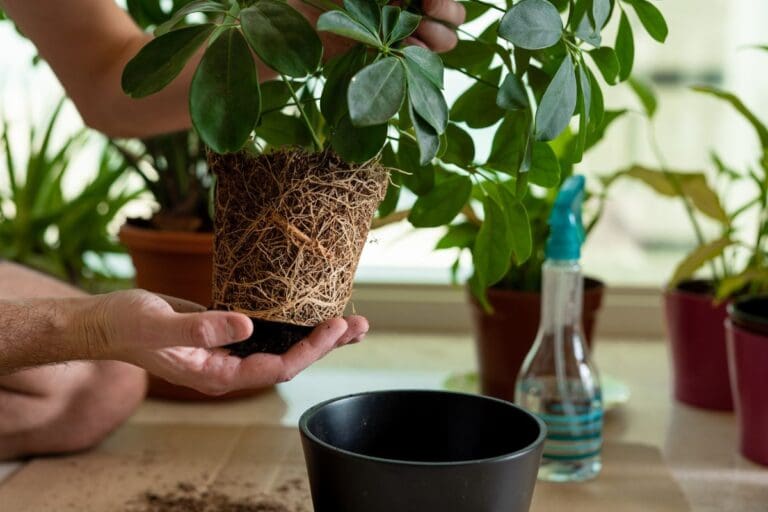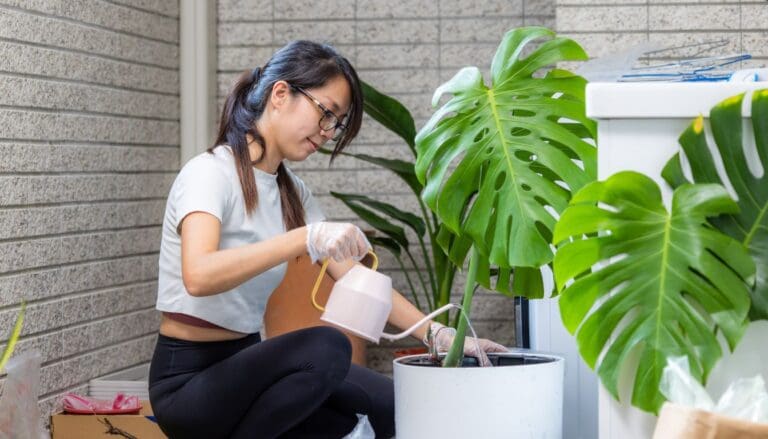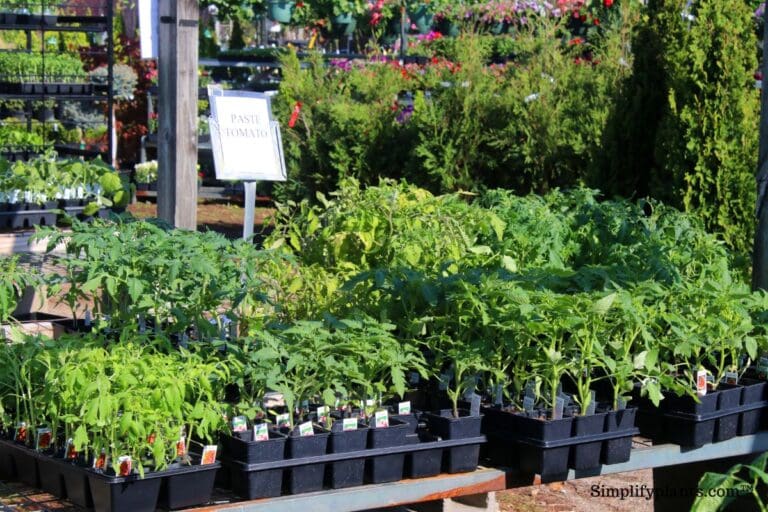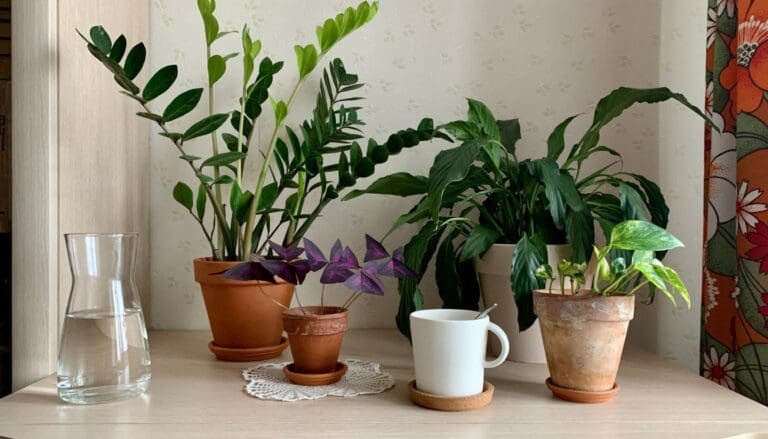Why Are My Indoor Plants Drooping? (Possible Problems+Solution)
We all love the beautiful shiny green leaves on our houseplants, along with colorful flowers. But it is sad to see these shiny leaves drooping down. The leaves tend to droop due to a lot of unfavorable conditions.
So, in this article, we shall learn why are your indoor plants drooping and how you can fix the same.
Lack of water is the primary cause of droopy leaves in indoor plants. Either underwatering or root rot due to overwatering leads to a situation where the plant doesn’t have enough moisture to hold its foliage resulting in droopy leaves. Other causes include low light, low humidity, and pest.
It is vital to give your plant all its requirements adequately on time. Overdoing anything or depriving them of anything will make your plant leaves droopy.
Droopy leaves are a common problem in all houseplants. However, they can be treated if action is taken immediately.
This article will help you know all the reasons behind droopy leaves and how you can get your plant healthy like before.

Please note: Simplify Plants is reader-supported. Some links in the post are affiliate links and I get a commission from purchases made through links in the post.
Why is my plant suddenly drooping?
There are several reasons for droopy leaves on houseplants. Some of the primary causes are:
- Improper light
- Incorrect watering
- Fertilizing issues
- Temperature stress
- Low humidity
- Pests
- Diseases
- Transplant shock
- Damages
- Dusty leaves
Let’s discuss the causes and their fixations in detail.
Improper light
A common reason why the leaves of indoor plants start drooping is insufficient light. Many houseplants can grow under low light. But extremely low light will only harm them.
Plants need sunlight to produce energy. There won’t be healthy photosynthesis and will cause them to droop down.
Similarly, if your houseplants love to grow under shade, exposing them to direct sunlight will cause them to droop downward due to scorching heat. Moreover, they will also have sunburns.
To fix the problem, consider keeping them under semi-shade or near a window that can give them bright but indirect sunlight. This indirect light will neither give them intense sunlight nor deprive them of light.
I would recommend you keep them near the north or east-facing window. This will give your plant bright sunlight, which will be less intense.
If your plant is placed near a south or west-facing window, consider keeping them a little away from the window. This direction receives too much sun. Use curtains or Venetian blinds to create a filter for the direct sunlight.
However, during continuous cloudy days, sunlight is rare. You can use grow lights to provide adequate light.
Incorrect watering

Another leading cause is inadequate watering. Both overwatering and under watering are the causes of droopy leaves in your indoor plants.
Excess water blocks the air pockets in the soil through which the roots get oxygen.
Due to this, the roots get suffocated and cannot absorb the nutrients and water from the soil. The plant, too, fails to receive water and nutrients, thus making the leaves droop.
When overwatering deteriorates, the roots start rotting due to overstaying in water. Along with droopy leaves, the leaves feel water-soaked. Your soil will also release a foul smell.
Overwatering also happens when you water too much or the soil doesn’t drain well.
Underwatering also causes droopy leaves in indoor plants. Most houseplants are moisture-loving plants. Starving them of water will cause them to droop down. Another reason is sandy soil. Sand drains water very quickly.
Watering differs depending on the plant size, seasons, and type.
A big plant will need more water than the smaller ones. During summers, plants need more water than winters.
Some plants like slightly damp conditions. So if you want to know the correct watering technique for your particular houseplant, consider researching.
Generally speaking, watering them thoroughly once a week will solve most of the watering problems. If the problem is poor soil drainage, fix it by adding compost.
This helps in improving both drainage and moisture retention. Consider marking a calendar to maintain a proper watering routine.
You have to take out the plant and remove the affected roots to treat root rot. You will have to repot your plant with new soil and new pot.
Use a pot relying on the plant size. An oversized pot will take a lot of time to let the soil dry. Use 1-2 inches bigger than the existing one.
Fertilizing issues
A thin line differentiates fertilizing and over-fertilizing your plant. Fertilizers help in providing your plants with sufficient nutrients.
Over-fertilizing will be harmful and toxic for your plants due to the presence of chemicals. Too much fertilizer will burn the roots. Due to damaged roots, the plant will no longer remain strong and healthy and will eventually droop.
- The first thing to do is prevent. If you are confused about the quantity, use less. It won’t harm your plant in any way.
- Next thing, be careful while fertilizing. Slow-release fertilizers are favorable and not even messy. You will not even have a fear of spilling too much, which happens mostly in liquid fertilizers.
- If you have already over-fertilized your plant, stop fertilizing for some time.
- Flush off the soil to get rid of the accumulated salts due to over-fertilization. But this should be done when the soil has completely dried up. Water very deeply and allow 20-30% of the water to drain from the drainage holes. This will help in flushing out the salts along with water. After that, you can start with regular watering.
Temperature stress and fluctuations
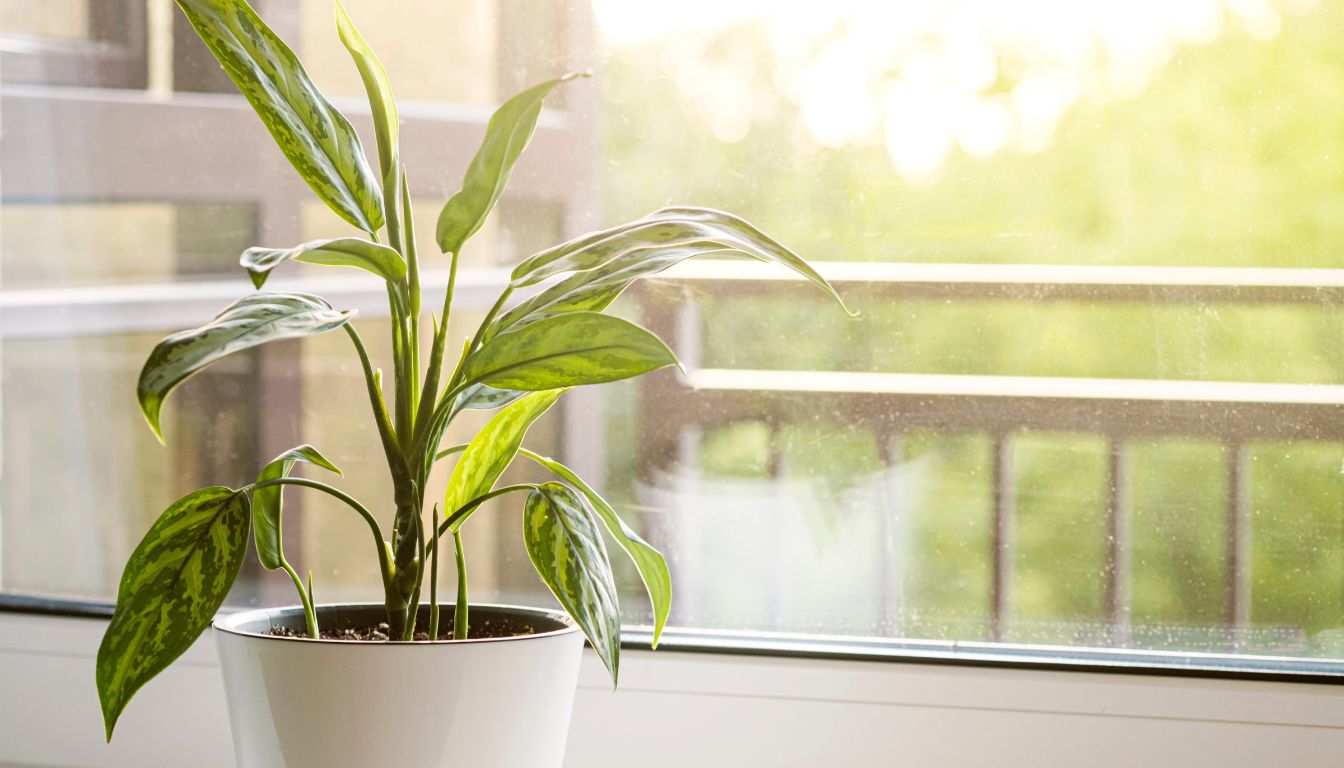
If your plant is drooping despite getting all the basic requirements, temperature stress can cause drooping.
Most indoor plants belong to tropical regions. They enjoy growing in warm temperatures. Exceedingly hot or cold temperatures will make them droop down. The ideal temperature for houseplants ranges between 55-90°F.
Some key points to keep in mind are:
- Do not keep them too close to devices like heaters, ovens, radiators, or air conditioners.
- Do not keep them near the windows or doors that are frequently closed and opened. This allows the drafts to enter the room and reach the plant, causing temperature fluctuations.
Low humidity
Originating from tropical areas, most indoor plants need high humidity to remain healthy. The humidity indoors is relatively lower than the humidity these plants get in their native land.
In winters, The weather remains dry. And the evaporation and transpiration rate increase. This reduces the humidity level in the plants.
Most of the indoor plant’s ideal humidity is above 60-70%. However, such high humidity is not possible to maintain indoors. But, still, at least you should give 50% humidity to them. To fix their humidity, you can do a lot of things.
- You can mist them regularly. However, it is temporary.
- You can keep your plants over a tray filled with pebbles. Fill the tray with water and pebbles, and keep your potted plant over it. Make sure the pot doesn’t touch the water.
- You can group many plants. This will help them maintain their humidity.
- Try keeping your plants inside a terrarium jar.
- If you have a separate room filled with all tropical houseplants, a humidifier is the best choice. Fix a humidifier in the room. It is a permanent solution, and all your plants will receive their ideal humidity. Humidifier mimics the exact humidity like the native land of the plants.
Pests

Everything you are doing is perfect for your plants. You are giving them adequate water, light, fertilizers, and even taking care of the temperature and humidity. But still, your plant has drooping leaves.
Give a close look at your plant, and you may find some uninvited guests– aphids, spider mites, mealybugs, scales, etc. These sap-sucking bugs feed on the plants’ sap and make the plant look tired and weak, along with droopy leaves.
Aphids are tiny and pale green to look that. You need a close look to discover them on your plants. Their size is that of a rice grain and is mainly found under the leaves.
Using some insecticidal soap or pyrethrin-based repellent will help you get rid of them.
Scales look like smooth bumps with indistinct strips at their back. They are a bit difficult to remove.
- Insecticidal soap will not help because of its protective shells. Neem oil is a good option. This will help in removing the bugs and will even help in curing the plant.
- You can also handpick them.
- Using cotton soaked in rubbing alcohol will too help to remove them from the plants. This will also clean the leaves.
Mealybugs look somewhat like scales, except they are white with a fuzzy appearance. Treat them the same way as aphids and scales. Spray these solutions 2-3 times a day for 7-10 days.
You can isolate the plant, discard the affected leaves, and then start these treatments for extra carefulness. For preventing more bugs, try spraying neem oil once every month. This will make the pests stay away from your plant, and if there is any such problem already, neem oil will fix it.
Diseases
Diseases like bacterial and fungal leaf spots, root rot, crown rot, stem rot, blackleg, botrytis, molds, viruses, and mildew will cause droopy leaves in indoor plants. Droopy leaves, yellow leaves, brown spots are the initial signs that your plant is diseased. If not treated on time, your plant will die.
These diseases have to be treated individually. You will have to isolate the plant and cut off the affected parts – leaves, stems, or roots.
Diseases harm the roots of the plant and damage the xylem in the leaves. Altogether they decrease water flow, nutrients, and oxygen. Without these critical needs, the plant starts drooping down due to bad health.
The only cure to this is prevention. When leaves droop, it means the disease has already occurred.
You will have to isolate the plant, check the plants and root system carefully, remove the damaged parts immediately and stop doing things that invited these diseases.
Diseases are probable reasons for damp conditions, wet and humid conditions together, poor ventilation, infected soil, long-term pest infestation, outside pathogens, etc.
- For cure, use fungicides after removing the affected parts.
- Spray the affected areas.
- Avoid deep watering and fertilizing for some days.
- Keep your plant in a place where they get bright sunlight and good airflow.
- Once your plant is healed, start its regular care. You might not be able to prevent the diseases. But with proper care, you will be able to suppress it.
Transplant shock

When transplanted, the plant receives an entirely new environment.
After staying in one kind of environment for a while and suddenly getting a new one will give your plant a shock. This shock will result in droopy leaves or yellow leaves. They might even fall off in some cases.
There is no treatment for this. You have to give your plant some time to get adjusted to the new environment. This is a natural thing.
- You will have to take care of them with proper water, light, temperature, and humidity in the meantime.
- Avoid giving the plant any other stress.
- Avoid fertilizing for at least six weeks.
Provide support
Sometimes, houseplants need little support to stand straight. When the leaves and stems are healthy, but the plant or the leaves are still drooping downwards, the plant is too heavy to hold itself. In such conditions, they need some support to be upright.
A stick or rod stuck into the soil will help in giving good support to the potted houseplants.
But there might be a risk of damaging the roots. Try giving support outside the pot. Consider using gardening ties or soft string to hold the plant and attach it to a stake gently.
Check for any damage
When only one part of your plant has droopy leaves, whereas the other parts are healthy and standing straight, the reason is that stem. This happens when the stem is cracked from the inside.
You do not always have to snap it off. You can give it support by straightening it and binding it with a cheesecloth at the broken part. This will heal the break.
Else you can remove it if you want. Snip off the broken stem and let the plant grow healthily.
Dusty leaves

The indoor plants that have waxy leaves accumulate dust on the surface.
It stops the light photons from touching the surface of the leaves and decreases photosynthesis. When filled with dust, the leaves cannot correctly regulate the moisture.
It will increase or decrease the transpiration rate in the plants, depending on the variety. All these problems altogether will make the leaves droop down.
To solve the problem, clean your plant leaves regularly. You can use wet clothes or cleaning wipes to remove dust. While using a wet cloth, allow the plant to stay under the sun for some time to dry up the wet leaves.
Final words
There are many reasons behind droopy leaves. Try taking care of your plants by providing all the requirements. If you think you are giving them all, maybe you are giving them too much or too little.
Try treating them by providing all the requirements alternatively. For example, if you think temperature is the problem, fix it.
Still, if you find it drooping, try other things, like watering more or less, removing them from the sun, or giving them proper light. Try everything alternatively to recognize the right reason.
Droopy leaves are the initial signs of the problems. You can revive your plant by giving them the right cure if you don’t neglect the sign. You just need to give them proper attention and regular close observation.
Recommended Garden Supplies
| Product Image | Our Recommended Gardening Supplies | Check Offers! |
|---|---|---|
Top Top
Top
Top
Top
Top
Top
Top
Top | rePotme Houseplant and Tropical Classic Potting Soil Mix | Check Offer On Amazon |
 Top
Top
Top
Top
Top
Top
Top
Top | Espoma Organic Indoor Plant Food | Check Offer On Amazon |
 Top
Top
Top
Top
Top
Top
Top
Top | GooingTop LED Grow Light 6000K Full Spectrum Clip Plant Growing Lamp | Check Offer On Amazon |
 Top
Top
Top
Top
Top
Top
Top
Top | Soil Moisture Meter | Check Offer On Amazon |
 Top
Top
Top
Top
Top
Top
Top
Top | Govee Hygrometer Thermometer, Bluetooth Enabled! | Check Offer On Amazon |
 Top
Top | LEVOIT Humidifiers for Large Room(Best For Plants) | Check Offer On Amazon |
 Top
Top
Top
Top
Top
Top
Top
Top | Upgraded DIY Automatic Drip Irrigation Kit, 15 Potted Houseplants Support | Check Offer On Amazon |
 Top
Top
Top
Top
Top
Top
Top
Top | Stainless Steel Heavy Duty Gardening Tool Set | Check Offer On Amazon |
 Top
Top
Top
Top
Top
Top
Top
Top | Bonide Insecticidal Soap | Check Offer On Amazon |
 Top
Top
Top
Top
Top
Top
Top
Top | Bonide 32 oz Spray Neem Oil for Organic Gardening | Check Offer On Amazon |
 Top
Top
Top
Top
Top
Top
Top
Top | Garden Safe Fungicide | Check Offer On Amazon |

